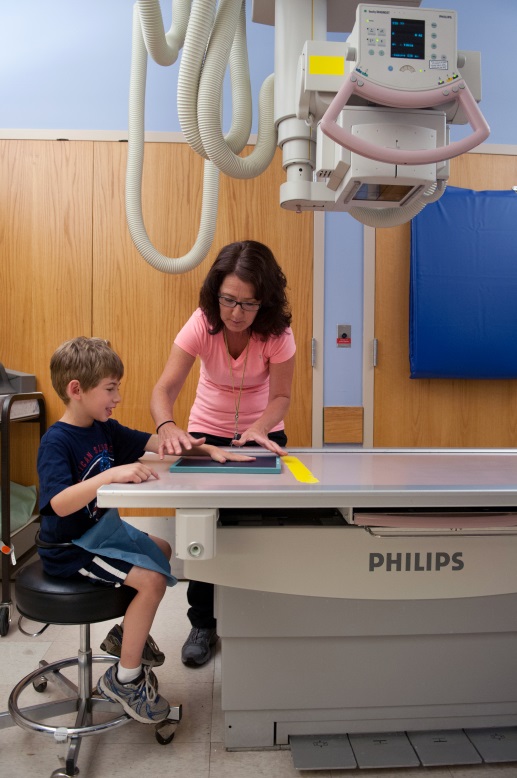What is an X-ray?
Conventional diagnostic radiology, also known as radiography, is most commonly known as X-ray. An X-ray is a picture of the inside of your child’s body. X-rays:
- Use small doses of ionizing radiation to produce diagnostic pictures of the human body
- Are the oldest and most frequently used form of medical imaging
- Are fast and easy to obtain, making them particularly useful in emergency diagnoses
Frequently asked questions
An X-ray is a picture taken of your child’s bones and organs by a large camera that uses radiation to take pictures of the inside of her body. The images are created when the X-ray passes through her bone and tissues onto a digital-image recording plate.
X-rays are commonly used to assist physicians in the diagnosis and assessment of many conditions, including:

There is no special preparation required for most X-rays. Your child can eat and drink as she usually does unless you are given specific instructions when you make the appointment.
It is helpful to:
- Give your child a simple explanation as to why she needs an X-ray.
- Assure your child that you will be there for the entire time. If you are pregnant, you will not be able to be next to your child when X-rays are taken. Bring another family member or friend to stay with your child.
- Bring your child’s favorite book, toy, or comforting object to occupy her while you wait.
When you arrive, please go to the Radiology check-in desk.
- A patient experience representative will check in your child and verify his or her registration information.
- Your child may be asked to change into a gown for his or her examination.
- Your child will need to remove any jewelry, eyeglasses, and any other metal objects that could obscure the images.
- Women should tell the technologist if there is any chance she could be pregnant.
A technologist will bring you and your child into the X-ray room. Your child will be awake at all times. The technologist will:
- Ask you and your child some screening questions
- Position your child on the X-ray table and place the digital recording plate under the table in the area of the body being imaged
- Use pillows or other positioning devices to help your child maintain the proper position
- Place a lead apron over your child’s pelvic area or breasts when possible to protect him/her from radiation
The X-ray will be taken by a large camera. The technologist will operate the X-ray machine from behind a wall in the room. Often, more than one X-ray is taken.
- Your child will be asked to sit, stand, or lie very still while the X-ray is being taken.
- Your child may be asked to hold her breath for a few seconds while the X-ray is taken.
The length of time needed to do each X-ray depends on the type of X-ray that was ordered for your child. A typical X-ray takes about 10 minutes for positioning, while the actual X-ray exposure takes less than a second.
There is no pain associated with having an X-ray. Your child may need to remain in an uncomfortable position for a short time while the X-ray is taken, but that discomfort is brief.
The benefit of an accurate diagnosis far outweighs the exposure to radiation that occurs during an X-ray. Because children are more sensitive to radiation exposure than adults, Boston Children’s Hospital specialists have been leaders in adjusting equipment and procedures to deliver the lowest possible dose to young patients.
When the X-ray is done, your child will be ready to go home or see her doctor if an appointment is scheduled. One of the radiologists will review your child’s images and create a written report of the findings and diagnosis.
The radiologist will provide a report to the doctor who ordered your child’s X-ray. The doctor will then discuss the results with you.
How Boston Children’s Hospital approaches conventional diagnostic radiology (X-ray)
Diagnostic radiology at Boston Children’s is designed to facilitate high-quality and rapid X-ray examinations using the lowest possible radiation doses for your child, no matter her size, age, or medical condition.
- Highly trained pediatric radiologists have expertise in interpreting X-rays in children of all ages.
- Technologists have years of experience in imaging children from infancy to teenagers.
- Skilled staff employ age-appropriate distraction techniques to help comfort patients prior to and during the procedure.
- Equipment is designed specifically for pediatric use, which means age-appropriate care for children.
- Protocols have been adapted to keep radiation exposure as low as reasonably achievable without compromising the image quality.
X-ray | Programs & Services
Departments
Radiology
Department
The Department of Radiology provides a full range of imaging services for newborns, infants, children, teenagers, young adults, and pregnant women.


